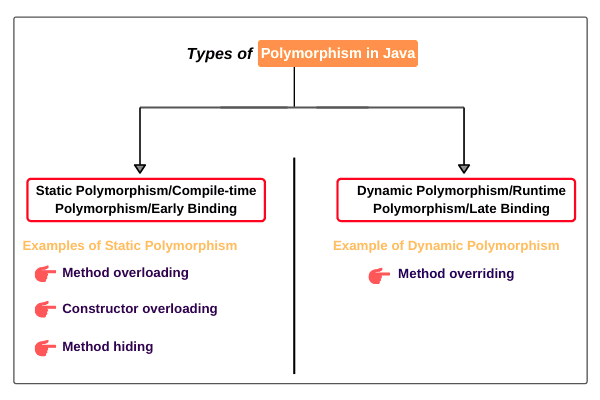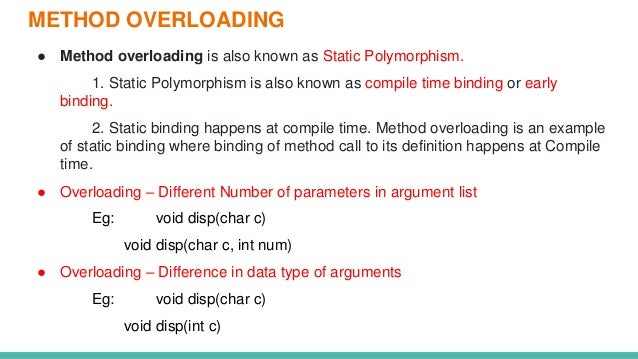


In other words, user need not to be concerned about which draw () method is executed in order to fulfil its requests. The advantage of polymorphism is that even for such heterogenous collection of different shapes, the general draw () method can be invoked, which automatically results in respective method being called according to the actual type of shape. With polymorphism, whenever a user wants to draw a particular shape (say circle), it simply sends the request to the super class Shape by invoking its method draw () which in reality be calling a method draw () of the appropriate sub class so as to display the requested shape. As the technique for drawing different shapes is unique so we have redefined (override) the draw () method in each of the subclass. In the above figure, draw() method is present in the base class Shape to draw any shape. The class hierarchy is as shown in the following figure. In order to simulate this, a separate version of draw a shape needs to be implemented for every class that describes a kind of shape (derive class). The user’s request in everyday language to draw a shape will therefore lead to various different actions.

Each shape in it may be completely different as eash may be of different structure and have different way of drawing such as rectangle, circle, triangle etc, If we want to draw different shapes, the same task has to be performed in principle (i.e, draw a shape) but depending on the shape, it may look very different as method for drawing each shape is different. In order to understand this concept, consider an example of collection of shapes in a Graphic package.
The important points to remember about polymorphism. Characteristics of Polymorphism in Java. Referencing Subclass Object using Superclass Reference Variable. #POLYMORPHISM JAVA CODE#
You can step through this code using the Java Visulaizer by clicking on the following link: Base Example.
The call to methodTwo in thodOne is to thodTwo which is the method from the Derived class. Finally the program returns to methodOne in the Derived class are prints "C". Then the "D" in the Derive methodTwo is printed. methodTwo in the Derived class is executed which then calls thodTwo which invokes printin "B" from methodTwo in the Base class. After the call to methodOne in the super class printing "A", the code continues with the implicit thodTwo which resolves from the current object's class which is Derived. So all methods are looked for starting with the Derived class. 
But the object is really a Derived object.
This would be true if the object was created of type Base using new Base. Even though b is declared as type Base it is created as an object of the Derived class, so all methods to it will be resolved starting with the Derived class. If not, the parent of that class will be checked and so on until the method is found. If the method is found there it will be executed. When a method is called at run-time the first place that is checked for that method is the class that created the object. Remember that an object keeps a reference to the class that created it (an object of the class called Class). At run-time the actual method that is called depends on the actual type of the object. The code won’t compile if the methods don’t exist in that class or some parent class of that class. But, you can only call methods that are available in the Object class unless you cast it back to the String class.Īt compile time the compiler uses the declared type to check that the methods you are trying to use are available to an object of that type. The class String inherits from the class Object so an Object variable can hold a reference to a String object. 11.23 Code Practice with Object Oriented ConceptsĪny object variable can refer to an object of the declared type or any descendant (subclass) of the declared type at run-time. 11.10 Access to Inherited Private Fields. 11.9 Using Super to call an Overridden Method. 11.1 Object-Oriented Programming Concepts.








 0 kommentar(er)
0 kommentar(er)
